Choosing the correct knitting needle size for your project is essential, but navigating the different systems of measurement can feel bewildering.
I’ll help you easily sort through the variety of numbers and measurements you might see on your needles and share a helpful knitting needle sizes chart with conversions.
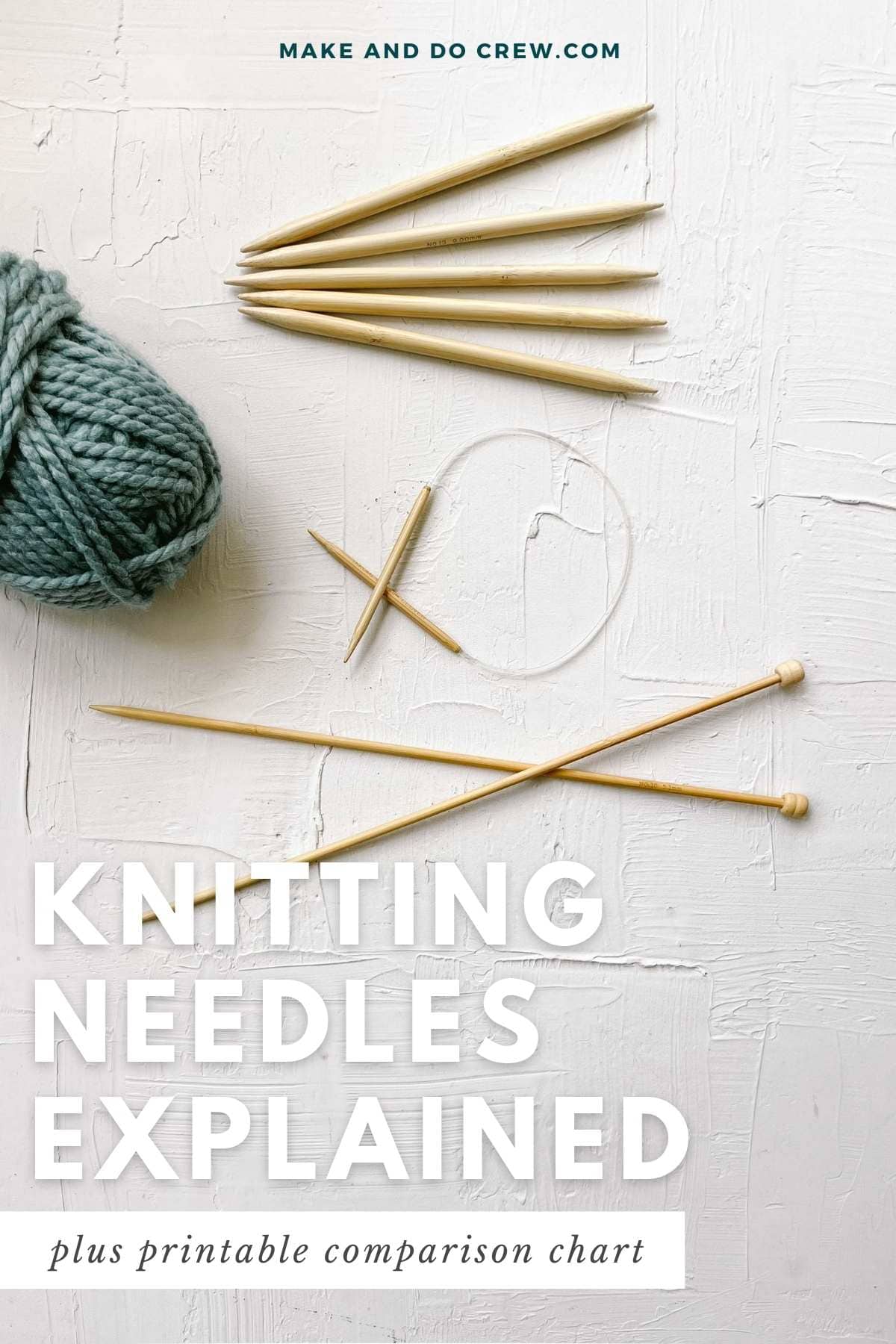
Knitting Needle Sizes Conversion Chart
Click here to download this printable knitting needle size chart and keep it handy so you can always know you’re using the correct needles.
Print it to keep in your knitting bag!
| Metric Size | US Size | UK Size | Japanese Size [Metric Measurement] |
|---|---|---|---|
| 1.0mm | 00000 (5/0) | 19 | - |
| 1.25mm | 0000 (4/0) | 18 | - |
| 1.5mm | 000 | 17 | - |
| 1.75mm | 00 | 15 | - |
| 2.0mm | 0 | 14 | 0 [2.1mm] |
| 2.25mm | 1 | 13 | 1 [2.4mm] |
| 2.5mm | - | - | 2 [2.7mm] |
| 2.75mm | 2 | 12 | - |
| 3.0mm | - | 11 | 3 [3.0mm] |
| 3.25mm | 3 | 10 | 4 [3.3mm] |
| 3.5mm | 4 | - | 5 [3.6mm] |
| 3.75mm | 5 | 9 | 6 [3.9mm] |
| 4.0mm | 6 | 8 | 7 [4.2mm] |
| 4.5mm | 7 | 7 | 8 [4.5mm] |
| 5.0mm | 8 | 6 | 9 [4.8mm]10 [5.1mm] |
| 5.5mm | 9 | 5 | 11 [5.4mm]12 [5.7mm] |
| 6.0mm | 10 | 4 | 13 [6.0mm] |
| 6.5mm | 10 ½ | 3 | 14 [6.3mm] |
| 7.0mm | - | 2 | 15 [6.6mm] |
| 7.5mm | - | 1 | |
| 8.0mm | 11 | 0 | |
| 9.0mm | 13 | 00 | |
| 10.0mm | 15 | 000 | |
| 12.5mm | 17 | ||
| 15mm | 19 | ||
| 19mm | 35 | ||
| 25mm | 50 | ||
| 35mm | 70 |
Knitting Needle Sizes Explained
When knitters talk about needle size, we mostly mean the diameter of the needle. But, to keep things interesting, the way needle diameters are classified differs across the world.
This means that the exact same sized knitting needle might be called one thing in Japan and something different in the United States. And you probably thought learning how to knit was the complicated part!
Measuring Systems
There are four common size systems for knitting needles which you will find used most frequently. Read or, or click to jump to your preferred measurement system.
Often, the sizes within these systems fall into the same range and even overlap in actual diameter. Since the diameters are frequently identical, you may already have the right needle, just labeled with a size from a different country’s system.
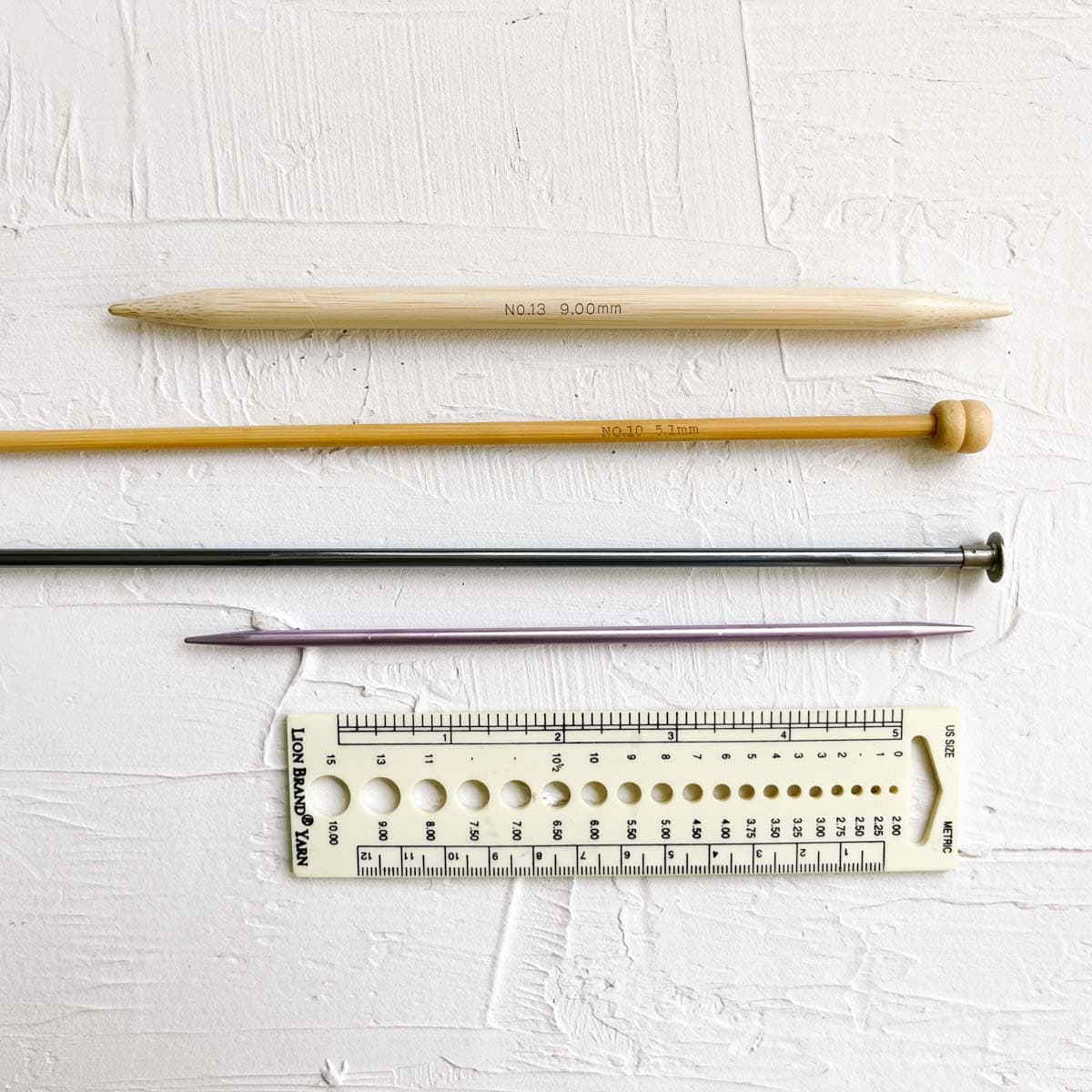
What Size are My Needles? It depends...
Unfortunately, each system uses a unique numbering scheme. This means that size labeling is the main difference between these four ways of categorizing needle size.
Generally, these classifications use one of two approaches: for some, a higher number means a larger needle, while other systems work the opposite way around. Not very simple, right?!
Let’s look at these four measuring and numbering systems and compare them in a knitting needle size chart.
Metric Sizes
As you might have guessed, needle size is measured in millimeters (mm) when metric units are used. Sizes are labeled simply with the needle diameter in millimeters. This makes the metric system perhaps the most universal knitting needle measurement.
This system also has the most comprehensive range of sizes available. Starting from 1.0 mm and reaching 35 mm, you can find needles of 28 different diameters.
Metric is most common in Europe, but more manufacturers around the world are starting to use it.
US Sizes
In the US system of measuring needle sizes, the thinner needle, the smaller the number used to label it. American sizes begin with 00000 (1mm) and go up to 70 (35mm).
The actual diameters generally align with the diameters of metric-sized needles, so the same size needle simply has a different label depending on the measurement system.
Old US System
To complicate knitting needle sizes further, there used to be a different measurement system used in the United States. This system worked the other way around, with smaller numbers referring to thicker needles.
Be aware that older knitting patterns may refer to the earlier US system. If you have an antique pair of needles you want to try out, make sure to measure them first. I’ll talk you through how to do this later.
UK Sizes
Larger numbers relate to thinner needles in the UK system. Similar to US sizing, British sizes generally use the same diameters as metric.
However, a smaller range of needle diameters are available with British sizes. The thinnest needle is 1 mm (size 19), while the thickest is 10 mm (size 000).
Japanese Sizes
In the Japanese sizing system, smaller numbers represent thinner needles. Compared to the previous three, this system has a smaller range of available diameters, ranging from 2.1 mm to 6.6 mm.
Each available size is 0.3 mm thicker than the needle before. Because of this, there is no equivalent metric needle with the exact same diameter as many Japanese sizes. Often, the difference between the metric, US, or UK size and the Japanese size is as slight as 0.1 or 0.2 mm.
What is the Best Needle Measuring System?
There is no single best measuring system, but it helps to know the different knitting needle sizing conventions. Before you start knitting, make sure you’ve got the right equipment by checking which measuring system your pattern or needle uses.
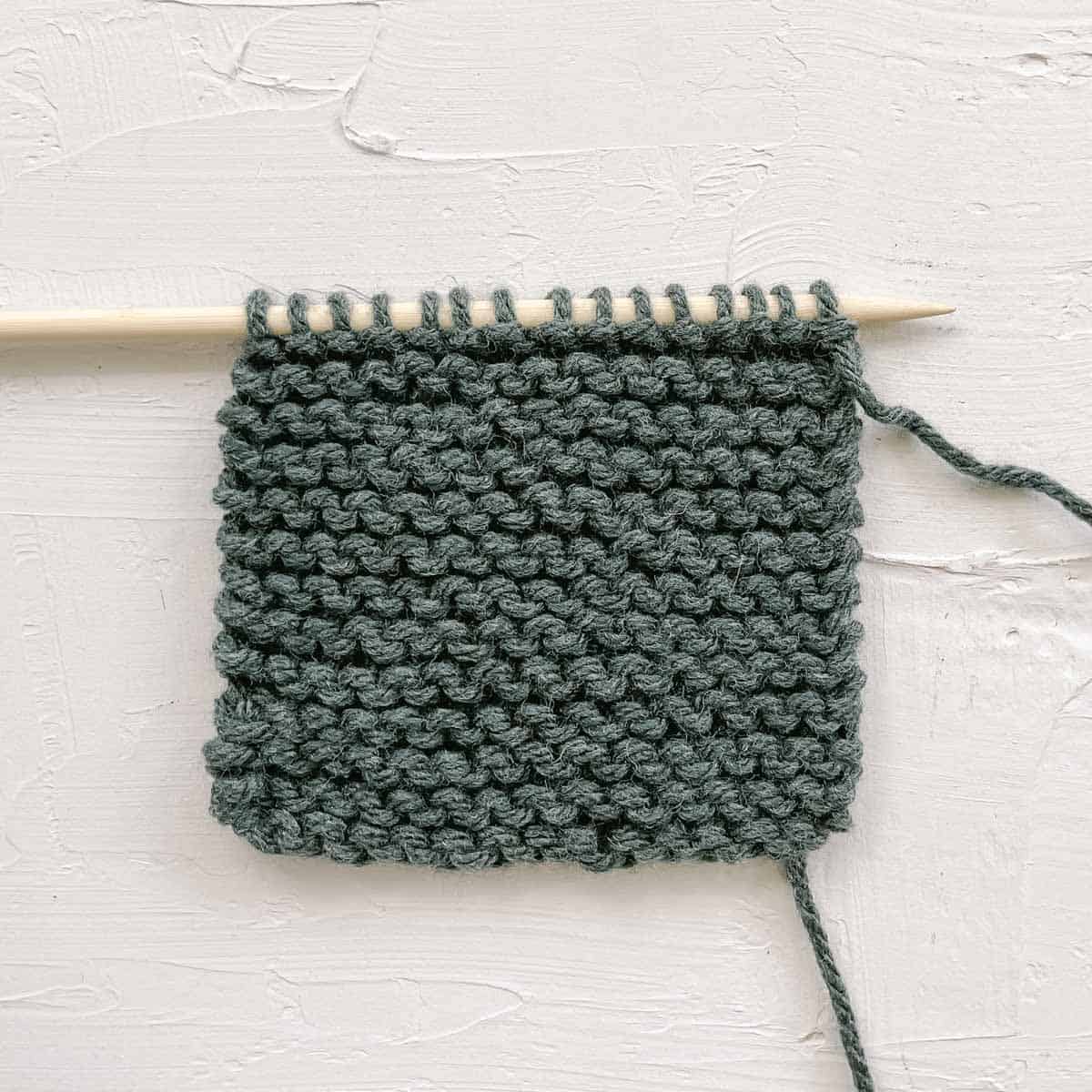
Picking the Right Needle Size and Yarn Weight
Since needle width directly affects the size of each stitch, size really does matter in the world of knitting. Along with your personal knitting tension, your combination of needle size and yarn weight heavily influences the finished look of your stitches.
Let’s say you’re knitting with worsted weight yarn. If you use bigger needles, you'll get a softer, more relaxed fabric with more space between each stitch. On the other hand, if you use smaller needles, you'll end up with a denser fabric, with less space between each stitch.
Which Needle Sizes for Which Yarn Weight?
There are a few simple ways to find the perfect match for your project. Most knitting patterns suggest a needle size and yarn weight, but it’s always important to make a gauge swatch to know if you’ll need to use a different needle size.
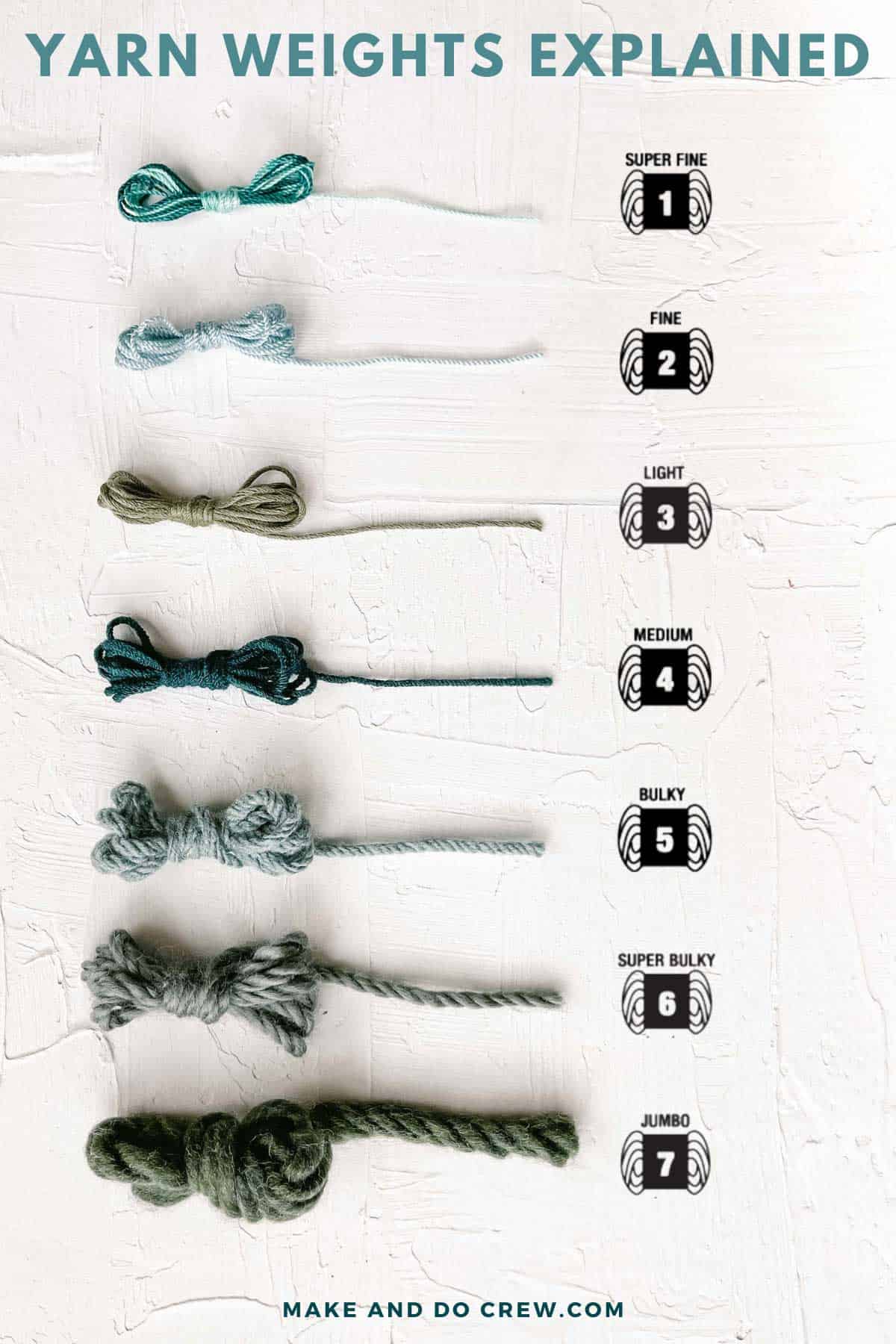
Check the Label
Yarn labels typically contain all the information you need to select the correct needle pairing. As I mentioned above though, you can deliberately choose to stray from this standard to achieve a certain stitch tension, such as in the case of dense knit mittens or lightweight, drapey knit sweaters.
Wanna save this pattern?
Needle Sizing and Yarn Weight Chart
A general rule of thumb is that the lighter the yarn, the thinner the needles needed. You can use this guideline to pair the right needle size with the yarn weight recommended in your chosen pattern.
This chart gives you a general outline of suggested metric measurements and US needle sizes for different yarn classifications.
| Yarn Weight | Metric Needle Measurement | US Needle Size |
|---|---|---|
| 0: Lace | 1.5 – 2.25 mm | 000 – 1 |
| 1: Superfine (fingering, sock) | 2.25 – 3.25 mm | 1 – 3 |
| 2: Fine (sport, baby) | 3.25 – 3.75 mm | 3 -5 |
| 3: Light (DK, light worsted) | 3.75 – 4.5 mm | 5 – 7 |
| 4: Medium (worsted, Aran) | 4.5 – 5.5 mm | 7 – 9 |
| 5: Bulky | 5.5 – 8 mm | 9 – 11 |
| 6: Super Bulky | 8 – 12.75 mm | 11 – 17 |
| 7: Jumbo | >12.75mm | >17 |
Which Needle Size and Yarn Weight for Beginners?
To achieve appropriate stitch tension, I recommend beginners start with size eight (5 mm) knitting needles and worsted weight yarn. I don’t recommend thinner yarn, such as DK weight or fingering, for beginner knitters because it can be frustratingly slow to make progress.
In terms of the needle length, it may be more comfortable to pick slightly shorter needles for your first project. I'll cover more details on needle length below.
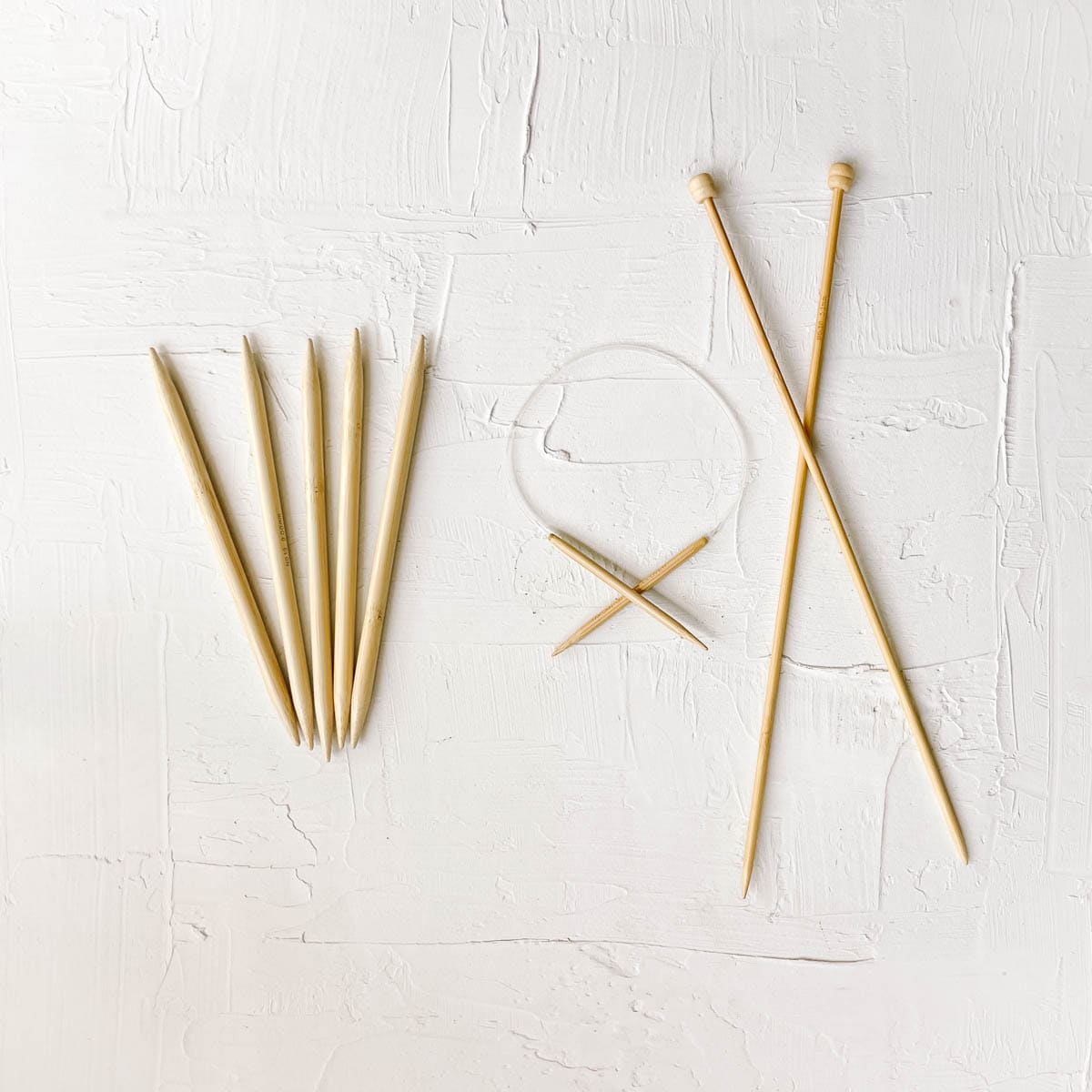
Choosing the Right Type and Length of Needle
There are three types of knitting needles:
- Straight needles - long, straight needles with a point at one tip.
- Circular needles - a set of two pointed needles connected by a flexible cable.
- Double-pointed needles (DPNs) - short needles with a point at each end, typically used in sets of four or five.
Each needle style is available in varying diameters and lengths, so you can find the perfect fit your needs.
Straight Needles
Straight, or single-pointed, knitting needles are great for creating flat projects. Think scarves, thinner shawls, and washcloths. Even some blankets that are made in strips can be knit with straight needles.
The standard length for straight knitting needles is 12-14 inches (30-35 cm). Beginners may find shorter, 10-inch (25 cm) needles easier to get to grips with during their first projects. If you are knitting something wider, like a sweater, consider longer, 16-inch (40 cm) needles.
Choosing the Right Length
When knitting projects with straight needles, the most important length consideration is that the needles are long enough to fit all the stitches. Besides that, the length makes no difference to the finished item as it does not affect the size of the individual stitches.
Circular Needles
Circular knitting needles are my favorite to invest in because they can be used anytime straight needles are appropriate plus in a couple of additional situations. There are two specific use cases where only circular knitting needles will work:
- When knitting larger seamless projects in the round and double-pointed needles can’t accommodate the number of stitches.
- When making flat projects, such as blankets or afghans, that include more stitches than straight needles can hold. The cable can also relieve your wrists from the growing weight of the knitting.
Tubular items like hats, socks, and mittens can be knitted on circular needles using a technique called the magic loop method. Magic loop knitting is a way to make smaller projects in the round while avoiding double pointed needles.
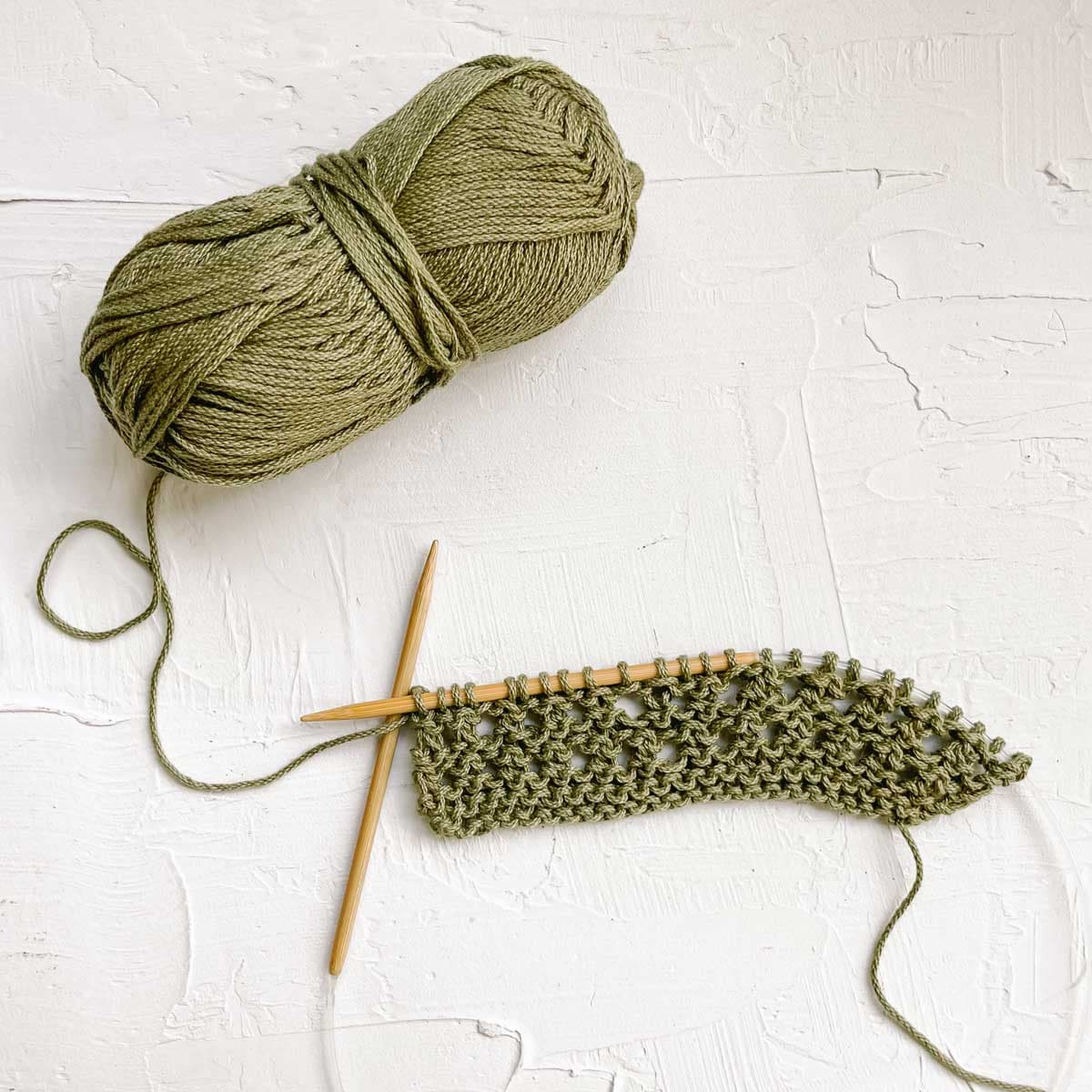
Choosing the Right Length
Circular needles are available in the same width sizes as straight needles. They also come in a variety of lengths: typically 16 inches, 24 inches, 32 inches, and 47 inches. The length measurement for these needles includes the length of both pins plus the cable.
The length you choose depends on if you are knitting in the round or flat and how many stitches you need to accomodate.
For flat projects: The knitting needle should be at least as long as the width of the finished item. Projects in the round will require the length of the needles to be the same size or slightly smaller than the circumference of the finished piece.
If the needle is much longer than the circumference, the stitches will stretch around the needle, negatively affecting your stitch tension.
Circular Needle Length Chart
Take a glance at this table for more information on choosing the right length circular knitting needles.
| Circular Needle Length | Items | Comments |
|---|---|---|
| >12” | Socks, mittens, baby hats, sleeves. | Narrow/small projects. For items smaller than 9”, use DPNs instead. |
| 16” | Hats, sleeves, collars. | Small, round projects. |
| #24” | Sweaters. | Projects in the flat or in the round. |
| 29” | Baby blankets, shawls. | Projects in the flat or in the round. |
| 36” | Blankets, shawls. | Flat knitting that’s more practical on circular needles. |
| >40” | Large blankets, shawls | Knit flat. |
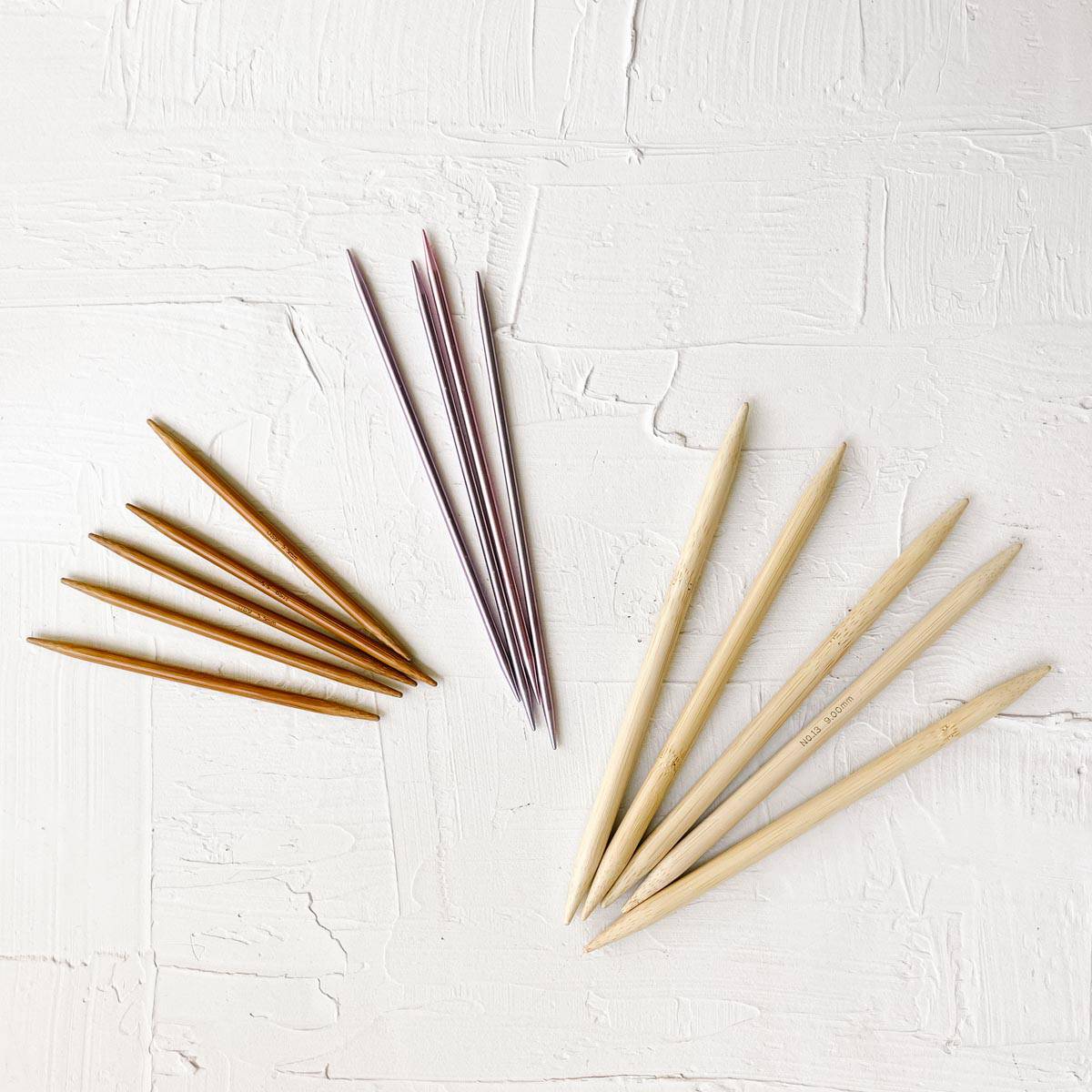
Double-Pointed Needles
Double-pointed needles (DPNs) are a crafter’s best friend for knitting small items that are worked in the round, such as bucket hats.
These specialized tools are perfect for petite ‘tube” projects or elements you cannot achieve with circular needles:
- Sleeves
- Socks
- Baby hats
- Slippers
- Decorations, dolls, and stuffed animals
Choosing the Right Length
Typically, popular sizes for DPNs are between five and eight inches, though they can be as short as four and as long as ten inches. However, length is not so important as long as the total number of stitches fits when divided across the set of DPNs.
Often, you’ll need to make the switch to DPNs when the stitches become too tight on your circular knitting needles. For example, you’re using a 16-inch circular knitting needle, you can easily transfer those stitches onto three five-inch DPNs.
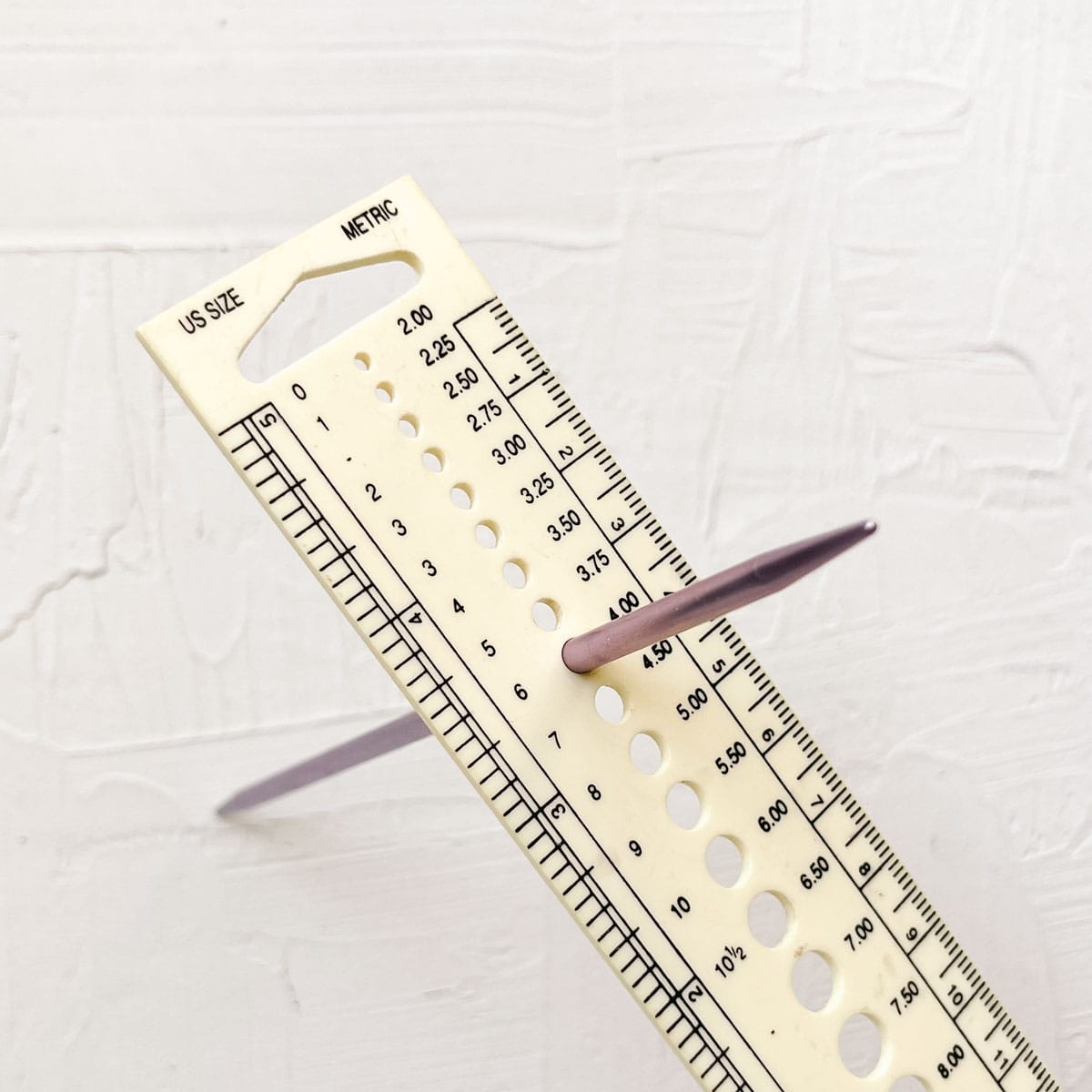
Measuring Needle Size
Most knitting needles have their size measurement documented on them. If you need to know what size needles you have, you can also use a needle gauge.
Measuring Needle Size (Thickness): A knitting needle gauge features holes labeled with different sizes. Slide your needle through the holes until you find the one that fits. It’s important to find the hole that fits the main diameter of the needle, not just the tapered tip.
Measuring Needle Length: A tape measure or ruler is the best way to measure the length of your knitting needles. Remember that the entire measurement of circular knitting needles includes the cable plus both needles, tip to tip.
FAQs
Knitting with the wrong needle size can affect your stitches' finished look and size. In turn, this will influence the dimensions of the final piece.
Using needles that are too large will make your project larger than expected. Using thinner needles will make your item undersized.
Knitting with too-thin needles will create smaller individual stitches, leading to a tighter fabric overall.
Knitting needles come in a variety of sizes, typically starting from a thickness of one or two mm and ranging up to 10 to 25 mm. Across the four common measuring systems, there are around 40 unique sizes of knitting needle diameter.
Bigger needles can be easier to knit with when you are learning the basics of the craft. This is because they are more straightforward to handle and create looser stitches than smaller needles.
Don’t overdo it, though! Knitting with needles that are too hefty can be uncomfortable and difficult. US sizes 8 to 11 are ideal for beginners.
US and UK knitting needles follow different measuring systems. While the numbering is different, the sizes typically fit into similar ranges and sometimes even share the same dimensions. In the UK, larger numbers mean thinner needles, while big numbers refer to thicker needles in America.
Always check to which measuring system a pattern refers or look for the measurement in millimeters.
Though knitting needles and crochet hooks are available in metric sizing (mm), the measuring systems are different for each. We measure the size of both tools by referring to the width of the shaft.
The similarities mostly stop there, though. For example, in the United States, knitting needle sizes are expressed through numbers, while crochet hook classifications consist of numbers and letters.
Different countries have their own conventions for measuring both knitting needles and crochet hooks. Look for a crochet hook or knitting needle size conversion chart if you are unsure.
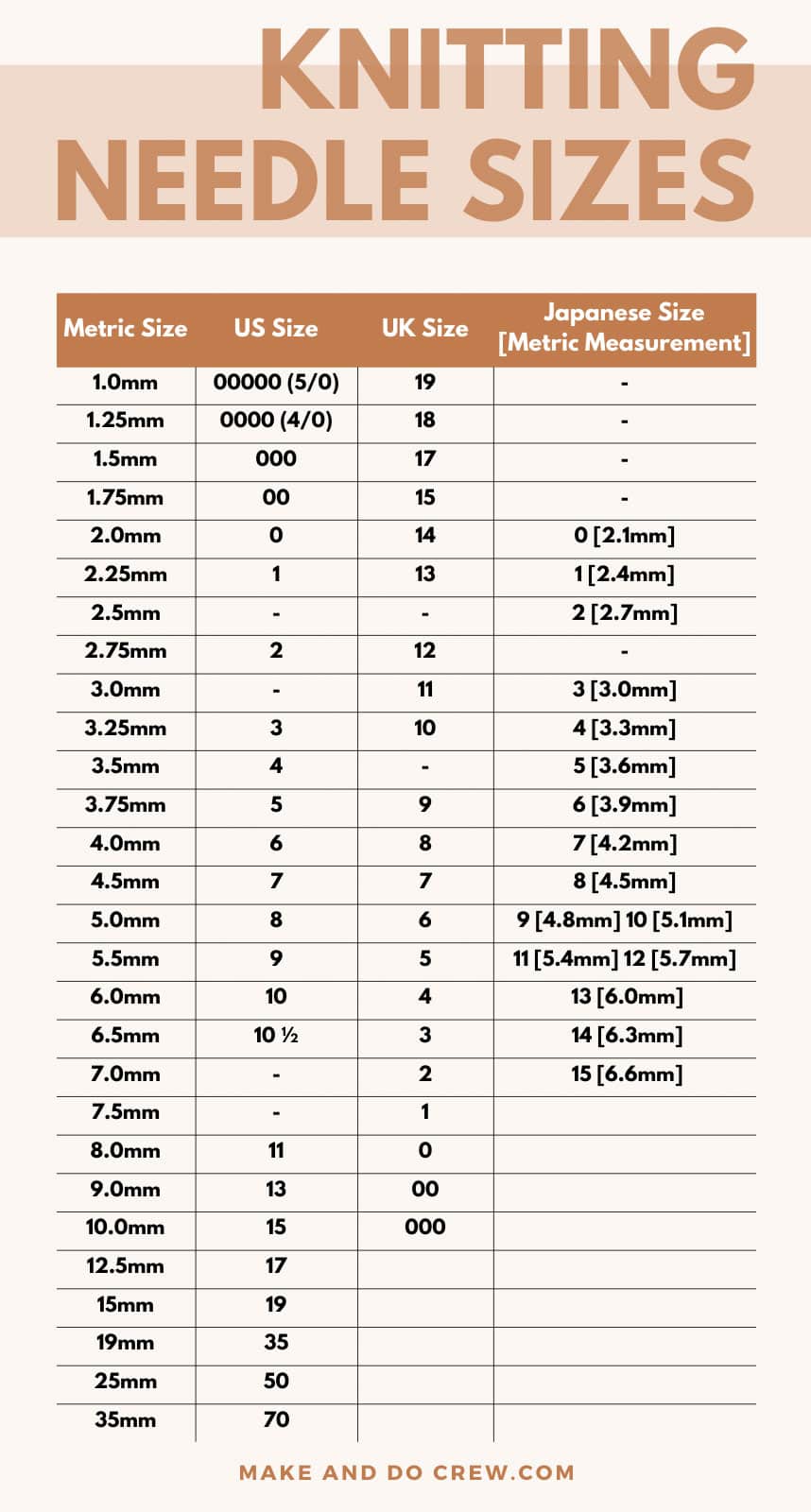

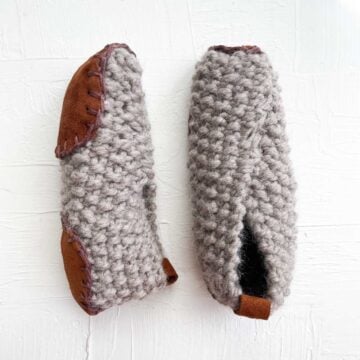
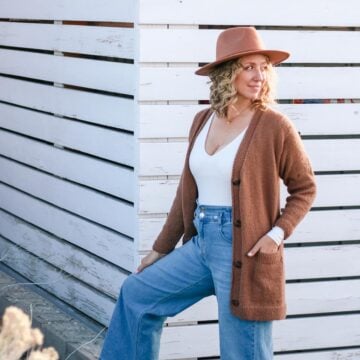
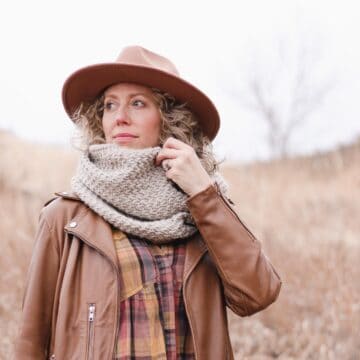
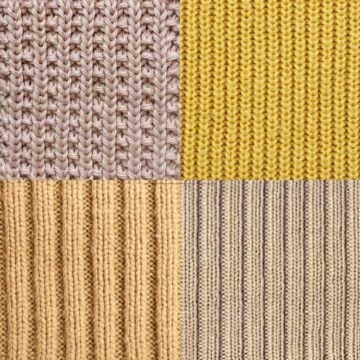
Leave a Reply